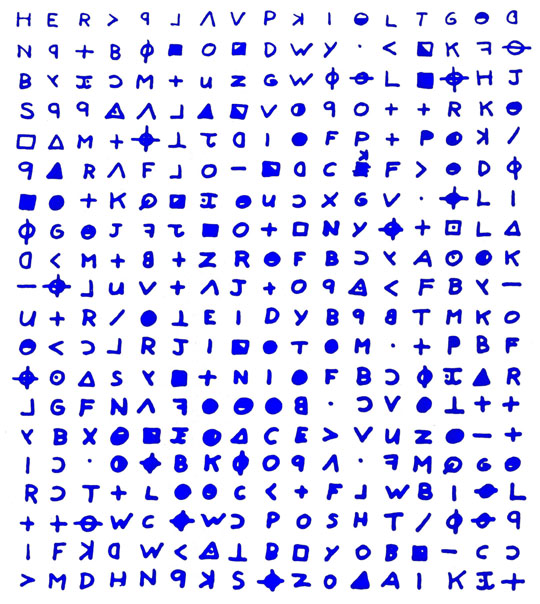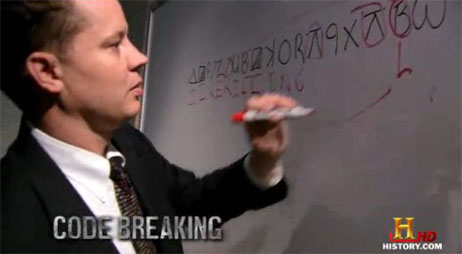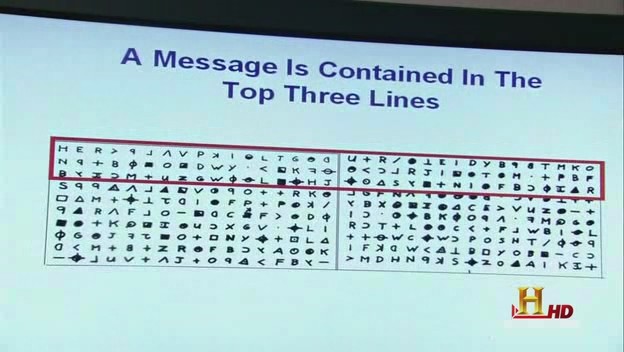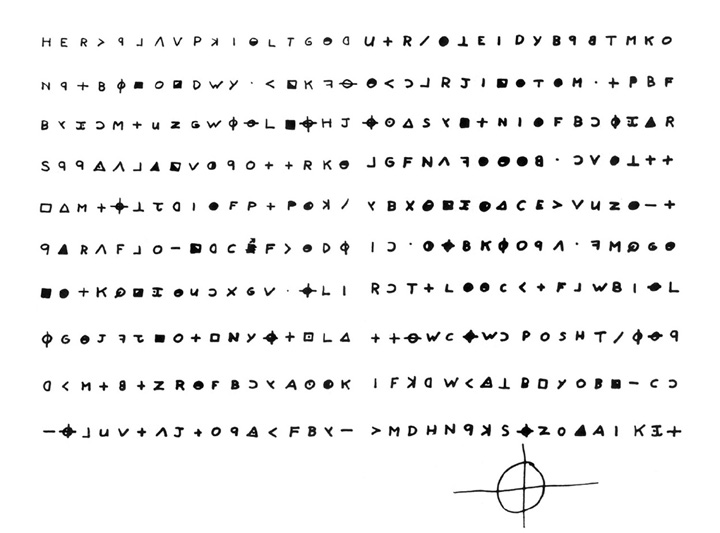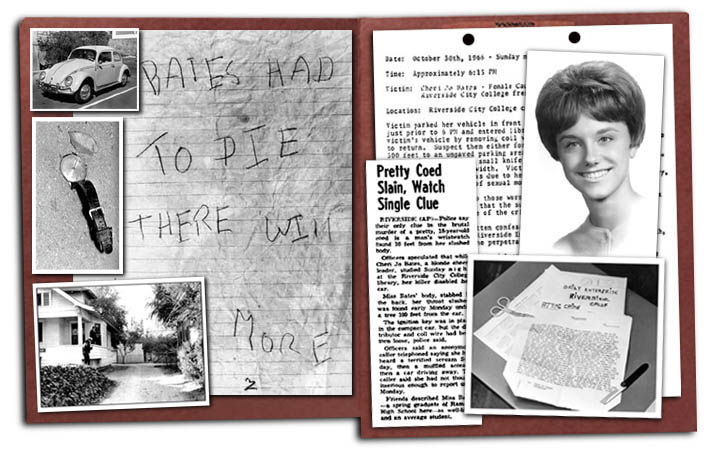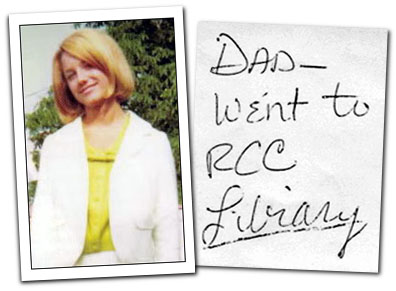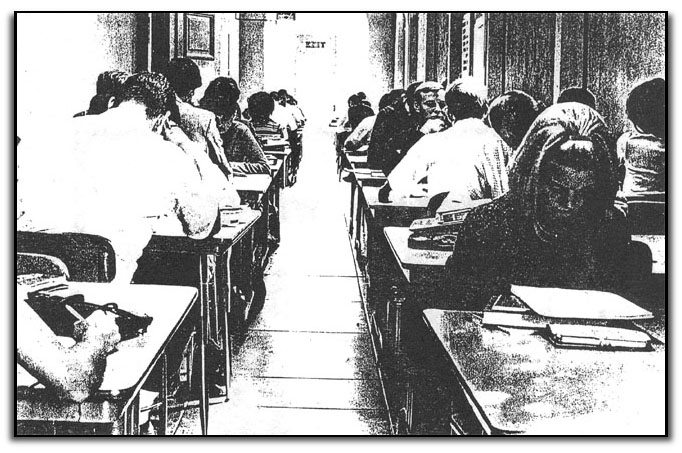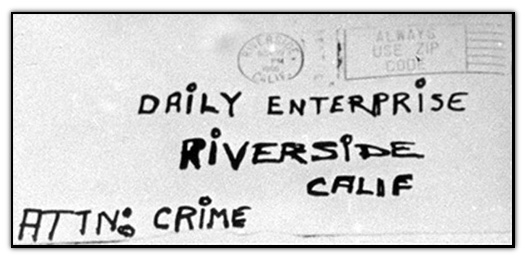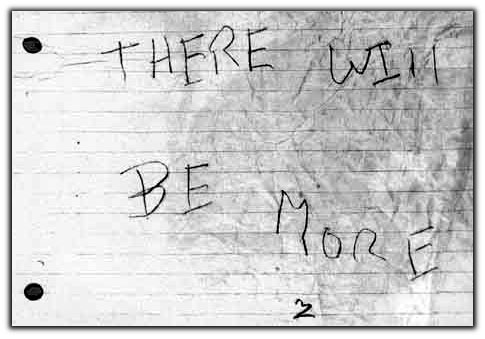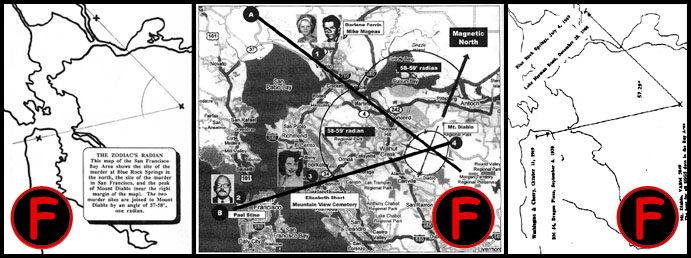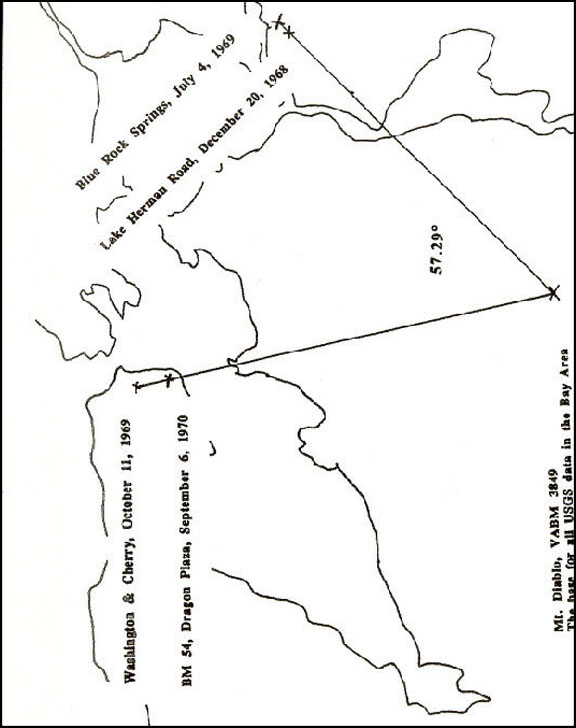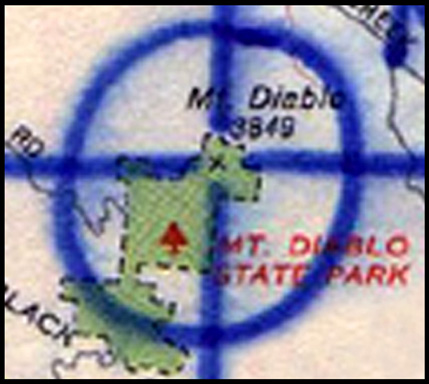The site is currently under a major overhaul…your patience is appreciated.
THE 340 CIPHER: Dead Ends
In November 1969, the Zodiac mailed his second cipher consisting of 340 symbols. Experts and amateur code breakers struggled with the cipher but repeatedly failed to find its hidden message. Over the decades, many people claimed to have solved the cipher but, to date, no one has produced a coherent and credible solution.
In his book Zodiac, Robert Graysmith claimed that he had solved the Zodiac’s “340 Cipher.” Graysmith’s claims as a code breaker earned him some local publicity in 1979, but his solution seemed rather incoherent.
HERB CAEN I GIVE THEM
HELL TOO BLAST THESE
LIES SLEUTH SHEOLH
SEE A NAME BELOW KILL-
LEERS FILM A PILLS GA-
ME PARDON ME AGCEPT T-
O BLAST NE BULLSHIE
HESE FOOLS SHALL ME-
ET KILLER PLEAS ASK
LUNBLAD SOLE AT PLSD
UL CLEAR IT LAKE IT SO
STARE I EAT A PILLLL
ASSHOLLE I PLANT MR
AH PHANE LAKE B ALLL
SLAVES BECAUSE DEAL
WILLL STOLEN EITHE-
R LATE TEA SPALL I HE-
LL SLASH TOSCHI THE
PIG M STALLS A O DEAL
C EIGHTH SOLE M SLAIN
The solution offered in Zodiac was an alteration of a version first presented by Graysmith in the late 1970s. The FBI files included an early version of Graysmith’s proposed solution:
Herb Caen: I give them hell too
to dead hell is a clue.
there some see a name below
a killer’s game is pills parole
me. Cops met to talk to me.
Such time. These fools helpd me.
Mad killer places a mask.
Bull S.
Alone pleasured I’d like to kill.
Scared I eat a pilll.
Asshole I plan to harm phone ask.
CB sells slaves because all
collection either please to lie in hell.
He’s me. Toschi the pig leads me.
Collects eighth some mail KT
Some people may have believed that Graysmith had deciphered the code, but the FBI was not impressed. On February 15, 1979, San Francisco police forwarded Graysmith’s solution, his worksheets and his code key to the FBI, and the Bureau reported its conclusions.
Based upon the information available, it is the opinion of respondent that the solution is not a valid decryption… The total feeling generated toward the decrypted solution is that the solution has been forced. First the random-like transposition system permitted the various vowels and consonants to be forced into words, then the words were forced into being poetry in an effort to give them meaning. Just about any random selection of words could be arranged to be as ‘logical’ as those in the supposed poetic solution. (It is noted that the initial ZODIAC decrypted message was particularly clear as to the meaning ZODIAC desired to communicate.) When a cryptogram has been decrypted properly there is an unmistakable sense of rightness about the solution. This sense of rightness is completely absent in the proposed solution.
Graysmith later altered portions of this solution and included the second version in his first book. Graysmith also claimed that his solution was confirmed by Greg Mellen and Eugene Waltz, both prominent members of the American Cryptogram Association. (Repeated requests for confirmation have been ignored by the ACA and no one at the organization appears willing to confirm Graysmith’s claim.)
The files of the Vallejo Police Department included one proposed partial solution to the 340 cipher which read:
You are getting closer than ever too catching me only I cannot arrange to meet with names no sir I to am through playing have a news tv or radio station tune to kgo tv at ten after seven am go to one or more at ot al of one that came to gather or meet with me.
During an interview for the History Channel’s 2009 documentary series MYSTERYQUEST, FBI code analyst Dan Olson speculated that some lines of the 340 cipher were meaningless filler while the relevant portions were buried inside other lines.
Olson also suggested that rearrangement of the cipher lines might be necessary in order to find the solution.
In June 2011, a man named Corey Starliper claimed that he had solved the 340 cipher and that the solution identified long-time suspect Arthur Leigh Allen as the Zodiac. Starliper was the center of attention for a brief period as the media repeated his sensational claims without question or scrutiny. The so-called “Starliper solution” spread across the Internet and the world. Starliper’s solution read:
KILL/SLF/DR/HELP/ME/KILL/MYSELF/GAS/CHAMBER
/AEIOUR/DAYS/QUESTIONSABLE/EVERYY/WAKING
/MOMENT/IM/ALIVE/MY/PRIDE/LOST/I/CANT/GO
/ON/LIVING/IN/THIS/WAY/KILLING/PEOPLE/I/HAV/KILLD
/SO/MANY/PEOPLE/CANT/HELP/MYSELF/IM/SO/ANGRY
/I/COULD/DO/MY/THING/IM/ALONE/IN/THIS/WORLD
/MY/WHOLE/LIFE/FUL/O/LIES/IM/UNABLE/TO/STOP
/BY/THE/TIME/YOU/SOLVE/THIS/I/WILL/HAV/KILLD
/ELEVEN/PEOPLE/PLEASE/HELP/ME/STOP/KILLING/PEOPLE
/PLEASE/MY/NAME/IS/LEIGH/ALLEN/
Starliper stated that he first became interested in the Zodiac case after seeing the 2007 film ZODIAC and reading the book version by Robert Graysmith. “I saw the movie first, and when I saw the movie, (I had) instant interest in it… When I read the book, I was … just hungry for more when the book ended… I became absolutely obsessed with the case, to the point that I’d look up from Graysmith’s books … and realize that I’d actually forgotten to eat.” The book and the film ZODIAC both presented a distorted and factually inaccurate account of the case which has been altered and embellished in order to lend credence to Graysmith’s theories while making Arthur Leigh Allen appear more guilty than the truth would permit. Starliper was admittedly influenced and inspired by the book and film, and his comments about the case, the evidence, Allen, and other subjects proved that he had relied on these unreliable sources for most of his information about the case.
Starliper’s solution was debunked on this website and others, and some media reports questioned his methods and results. Starliper became defensive and even threatened those who dared to dismiss his claims. In an article titled “Proposed Zodiac 340 Solution Comes Under Fire,” Starliper was quoted as saying, “I believe there is enough evidence to suggest that my solution is valid. However, it really is anyone’s guess … For all anybody knows, (the Zodiac’s) code could be the alphabet repeated 30 times over.” On his Facebook page, Starliper confessed, “The solution may be incorrect but its just as valid as anyone else’s guess.” Dave Oranchak’s website ZodiacKillerCiphers.com featured an article which debunked Starliper’s solution. Oranchak wrote, “His solution is a hoax . . . Corey’s system allows him great freedom to guess words that fit his preconceived notions of the Zodiac case. His guesses are no better than any one else’s guesses, and his solution has no significance.”
Starliper’s methods and results highlighted the persistent problem with the many proposed solutions offered by Graysmith and others. Using preconceived notions, Donald and Bettye Harden unlocked the Zodiac’s first cipher. The Hardens assumed that the killer’s ego would dictate that the message began with the word “I,” and, that the killer’s need to brag about his crimes would dictate that the message also included the word “kill.” These assumptions proved correct, and the Harden’s produced a clear and coherent solution which began, “I like killing people because it is so much fun.” Experts confirmed the accuracy of the Harden solution and the deciphered message is generally accepted as valid. The Hardens based their assumption on basic facts about the killer’s letters and they produced a message which contained clear sentences of coherent text. The methods used could be verified and duplicated by others, and, the solution was did not appear forced. Robert Graysmith, Corey Starliper and many others had proposed solutions for the 340 cipher which appeared forced to fit several preconceived assumptions about the killer and his identity. Those assumptions were not based on fact and the results were not sound. As the FBI analyst noted, “just about any random selection of words could be arranged to be as ‘logical’” when using such methods. The Harden’s were successful in deciphering the Zodiac’s cipher because their method relied on the basic facts and common sense.
The 340 cipher has been the subject of debate, scrutiny and controversy for more than four decades. To date, no one has deciphered the hidden message. Computer programmer David Oranchak developed the “Zodiac web toy,” a cryptography website where visitors can use a program designed to test their own solutions. The Zodiac’s first cipher was solved by determined amateur code breakers in search of the truth. Perhaps another dedicated amateur will someday unlock the mysteries of the Zodiac’s 340 symbol cipher.
RELATED LINKS:
The FBI FILES: 1979 – Graysmith’s 340 Solution
ZodiacKillerCiphers.com – Attacking the 340 using genetic programming
Harden Worksheets: Page 1 – Page 2 – Page 3
_______________
Copyright 2013 ZodiacKillerFacts.com
RIVERSIDE ACTIVITY: Unsolved Mysteries
The murder of Cheri Jo Bates remains one of the most controversial chapters in the history of the Zodiac mystery. Bates was murdered near the Riverside City College library on the night of October 30, 1966. One month later, someone mailed an envelope to the Riverside Press-Enterprise newspaper which contained a letter titled “The Confession.” The writer described the murder and claimed responsibility for the crime. Police believed that the killer was the author of the confession letter. Six months after the murder, three virtually identical handwritten letters were sent to the newspaper, Riverside police and the father of Cheri Jo Bates. The text read, “Bates had to die. There will be more.” (The letter to Mr. Bates began, “She had to die…”) Each of these letters featured a small symbol at the bottom of the page which appeared similar to the letter “Z.”
In October 1969, the Zodiac crimes were widely reported in the news and eventually the Riverside Police Department noted similarities to the unsolved Bates case. Chief Thomas Kinkead contacted Special Agent Mel Nicolai at the California Department of Justice, who assisted the various law enforcement agencies involved in the Zodiac investigation. Kinkead shared the details regarding the Bates murder and Nicolai directed the chief to the Napa County Sheriff’s Office. Kinkead spoke to Sheriff Earl Randoll by telephone on October 17, 1969. Kinkead then sent a letter which provided the basic facts regarding the Bates murder and the written communications from someone who claimed to be the killer. Kinkead’s letter read in part:
“There are numerous similarities in your homicide and our Inv. 352-481. I thought you should be aware that we are working a similar type homicide investigation. If you are able to determine by handwriting comparison or by any other means that your homicide suspect is the same as ours, please advice. I will notify you of the results in comparing your latent lifts with ours as soon as I hear from the FBI. I hope this information may aid in your investigation. Please be assured of our complete cooperation in all matters of mutual interest.”
Fingerprints related to the Bates case were compared to the fingerprints related to the Zodiac investigation but no match was found. However, the prints in both cases did not represent every part of every finger on both hands so the possibility existed that the prints could not be matched at all. Despite the apparent lack of a connection between the fingerprint evidence, the various law enforcement agencies strongly believed that the Zodiac may have killed Bates. Questioned Document Examiner Sherwood Morrill concluded that the Zodiac was responsible for writings attributed to the Bates killer as well as a morbid poem etched into a desk discovered in the Riverside City College library. Morrill’s conclusion would be supported and challenged by other experts in later years, but many people believed that the Zodiac was the most likely suspect in the Bates murder.
THE RIVERSIDE CONNECTION
In November 1970, the San Francisco Chronicle published a story by reporter Paul Avery which revealed the possible connection between the Zodiac killer and the Bates murder. The so-called “Riverside connection” was widely reported and, although some members of the RPD expressed skepticism or doubt about the connection, the department’s communications with the FBI and other agencies indicated an interest in this theory. In later years, Riverside authorities abandoned the suspected connection between the Bates murder and the Zodiac crimes in favor of the theory that Bates was killed by someone she had known. The department dedicated its time and resources to this theory and denied that their case was connected to the Zodiac. On May 20, 1982, the Riverside Police Department issued a press release which read in part:
In November of 1981, new information came to light which resulted in the assignment of four investigators to work full time on this case. These investigators recontacted numerous persons who were either known the victim or were known to associate with an individual we believe responsible for this crime. Current past known associates have been interviewed in depth. All of the physical evidence related to this crime has been re-evaluated and some instances forensically examined… The alleged connection with the “Zodiac” by certain media and inquisitive individuals was anticipated when a decision was made to release this information. The showing of very old composites and the review of previously examined cryptic writings by some of the media, have resulted in considerable interest by the rest of the media whose knowledge of the “Zodiac” is based on out-dated information linking this investigation with those referred to as “Zodiac” cases. Speculation and creative reporting of this kind could conceivably hamper successful prosecution. The person we believe responsible for the slaying of Cheri Jo Bates is not the individual other law enforcement authorities believe responsible for the so called “Zodiac” killings.
The Riverside Police Department blamed “the media” and “inquisitive individuals” for the notion of a connection between the Zodiac killer and the Bates murder. The RPD press release did not mention the fact that the department had previously informed the Department of Justice, the FBI and other agencies that the RPD believed there could be a connection between the Zodiac killer and the Bates murder. In fact, no one had suggested such a connection existed until the Riverside Police Department contacted the Department of Justice in 1969. The DOJ then issued a report, based in part on the information provided by the RPD, which included the Bates murder as a possible Zodiac crime.
In 1999, Riverside police hoped to solve the Bates murder and end speculation of a possible Zodiac connection. Investigators obtained samples from their suspect for DNA comparisons with evidence found at the scene of the crime. Riverside police sent requests to the FBI and the Department of Justice for assistance. These documents revealed the results of forensic tests.
DOJ / FBI – Submission by Riverside Police Department – 4-1-99
Victim murdered at City College, died of multiple stab wounds to neck. Possible forged letter by Zodiac claiming responsibility for homicide. Suspect hair removed from victim’s hand at autopsy. DNA extracted from hair. Whole blood sample taken from suspect.
The document also specified the evidence as “mitochondrial” DNA discovered in the “Hair from blood clot found at base of Cheri Jo Bates’ right thumb.” Samples taken from the suspect were then compared with this evidence and the results were reported in a subsequent FBI document dated June 21, 1999.
The four (4) brown Caucasian head hair fragments found in specimen Q1 are microscopically dissimilar to hairs in the submitted known head hair sample (K3). Accordingly, these hairs could not be associated to CHERI JO BATES, the identified source of the K3 hairs. These hairs have been preserved on a glass microscope slide for possible future comparisons. No hairs microscopically dissimilar to hairs in the submitted known head hair sample from the victim (K3) were found on the Q4 glass microscope slide. No other hair and fiber examinations were conducted.
Further information was reported by the Bureau on March 13, 2000:
Results of examinations: A mitochondrial DNA (mt DNA) sequence was obtained from the Q1.1 hair from the blood clot at the base of CHERI JO BATES’ right thumb and the K1 blood sample from [REDACTED] (positions 73-340). The mtDNA sequence obtained from specimen Q1.1 is different from the mtDNA sequence obtained from specimen K1. Therefore, [name REDACTED] can be eliminated as the source of the Q1.1 hair. There was insufficient mtDNA present for a mtDNA sequence to be obtained from K3.1 and K3.2 head hairs from CHERI JO BATES. No other mtDNA examinations were conducted.
Riverside investigators had hoped that the DNA comparison would finally link the suspect to the Bates murder, but the results proved that the suspect was “eliminated as the source” of the hair found in the hand of the victim. Some sources had claimed that other damning evidence had implicated the RPD suspect in the murder of Cheri Jo Bates. All of the so-called “evidence” consisted of stories told by individuals who did not report this seemingly-important information to authorities at the time of the original investigation. According to some sources, these witnesses also submitted to polygraph examinations and the results were either inconclusive or indicated some degree of deception. The lack of credible and substantial evidence implicating the suspect in the crime seemed even more troubling after the DNA a comparison had excluded the suspect. The exclusionary evidence was obtained from the hairs found on the victim’s hand, a strong indication that the hair belonged to the killer. This hair was not similar to the hair of the RPD suspect and the DNA testing proved that the hair did not belong to him. Common sense, logic, the facts and the evidence indicated that the RPD suspect did not kill Cheri Jo Bates and, instead, pointed to other potential suspects and an alternate theory of the crime.
THE REST OF THE STORY
I made my first trip to Riverside in January, 1999, before the RPD conducted the DNA comparisons. I contacted Steve Shumway, the detective then in charge of the case, and stated the purpose of my inquiry. Shumway replied, “Is this the same Michael Butterfield who wrote this article I have in front of me?” He then said, (paraphrase), “You’re taking some pretty tough shots at us here.” I did my best to explain my position on the issues but the detective was clearly not interested in discussing any possible link between the Zodiac and the Bates murder.
At the time, rumors had circulated that the department was developing a strong case against their favored suspect, a man identified on the Internet by the name of “Bob Barnett,” who was first identified as a suspect in 1968. According to the police version of events, Barnett had dated Bates in the weeks before her death. Barnett himself denied that he had ever dated Bates at all. Police sources claimed that Barnett had fought with the victim in public and even slapped Bates across the face in front of witnesses. Further, on the night of the murder, Barnett purportedly told others, “That bitch is going to the library.” Bates was killed near the Riverside City College library on the same night.
According to some sources, unidentified witnesses allegedly told police that Barnett had confessed to killing Bates, and, one witness allegedly claimed that he had visited the crime scene with Barnett on the night of the murder. Other rumors linked Barnett to a watch which was similar to the one found at the crime scene and the military boot prints found near the victim’s body. Despite this seemingly damning evidence against Barnett, police never filed charges against Barnett, and the reason may have been simple– the evidence and witnesses were questionable, at best.
During our conversation, Detective Shumway claimed that Cheri Jo Bates was the victim of a “rage-killing” and had been killed by someone she had known. To support that theory of the crime, Shumway claimed that Bates had been stabbed as many as forty-two times. This scenario was disturbing, for a variety of reasons. If the detective’s claim was true, the RPD had managed to withhold those details over decades. The savagery and overkill attributed to the Bates killer was not compatible with the Zodiac crimes. The Zodiac did not engage in acts of overkill or torture and his behavior indicated that he did not inflict wounds in order to satisfy a sadistic appetite. That fact would suggest that the Zodiac was not responsible for the Bates murder but the RPD never mentioned this during the many years spent denying any connection existed. If Bates had been stabbed over forty times, that fact did not necessarily indicate that she had known the killer– many killers have inflicted such violence on victims they did not know prior to the moment of the attack.
After my trip to Riverside, the report detailing the autopsy of Cheri Jo Bates surfaced on the Internet. The report clearly refuted the scenario that Bates had been stabbed as many as forty-two times. The report indicated that the actual number of stab wounds was far less than forty-two, and, despite the violence unleashed on the victim, the notion that the murder was an act of personal rage by someone who had known Bates was not supported by the facts. The theory endorsed by the Riverside police no longer seemed plausible. In fact, the autopsy report did more to support the version of the crime as described in the anonymous “confession” letter.
In its communications to the Department of Justice and the FBI in 1999, the Riverside Police Department referred to a “possible forged letter by Zodiac claiming responsibility for homicide.” The wording appears to make a clear distinction between a Zodiac “hoax” letter and a letter written by the Zodiac. The word “forged” indicates that the RPD believed that the Zodiac had written the “confession” letter and other writings to claim responsibility for a crime he did not commit. In this RPD scenario, Barnett had killed Bates but the Zodiac wrote to declare that he had done so. Ironically, the author of the confession wrote that Bates had dismissed him for “years,” thereby implicating someone who had known Bates just as the RPD later believed.
In its 1982 press release, the RPD complained that the media and other “inquisitive individuals” had incorrectly linked the Zodiac to the investigation of the Bates murder. According to the RPD, those who claimed a connection existed between the two cases had based their conclusions on “out-dated information”. However, the wording of the 1999 FBI/DOJ document indicates that the RPD believed the Zodiac was responsible for the “confession” letter and other “cryptic writings” associated with the Bates case. If correct, that conclusion clearly demonstrated a substantial link between the Zodiac and the Bates case, even if the Zodiac did not kill Bates. In 1966, the RPD concluded that the author of the “confession” letter possessed knowledge of the Bates murder which was known only to the killer. In 1999, the RPD appeared to concede that the Zodiac may have written the “confession.” Even if the Zodiac did not kill Bates, his interest in the case and his apparent access to sufficient information needed to “forge” a convincing “confession” would undoubtedly be of interest to anyone investigating either of the two cases. If the Zodiac did send the Riverside writings, forensic testing of those documents could produce evidence which could identify the Zodiac. The fact that one of the most notorious serial killers in modern American history apparently began his career by mailing letters claiming responsibility for the Bates murder would strongly suggest that a thorough investigation would explore the potential connections between the Bates murder and the Zodiac killer.
SIGNS OF THE ZODIAC
At the time of the original Zodiac investigation, Special Agent Nicolai prepared a report for the Department of Justice which included information about the crimes linked to the Zodiac. The Bates case was cited along with the other four known attacks in the San Francisco Bay Area. The DOJ report referred to the writings related to the Bates murder.
“Suspect mailed typewritten confession letter from Riverside to the Police Department and Riverside Enterprise newspaper on November 29th, 1966, claiming to the perpetrator of the crime. Three additional handprinted letters were mailed in Riverside by the suspect on April 30th, 1967, again claiming the Bates homicide and indicating there would be more.”
After the Bates murder, Riverside police, the local newspaper and Bates’ father received three virtually identical handwritten letters in April 1967. The Zodiac’s first written attempt to communicate consisted of three virtually identical handwritten letters mailed in July, 1969. The author of the Riverside “Confession” wrote, “SHE SQUIRMED AND SHOOK AS I CHOAKED HER, AND HER LIPS TWICHED.” In his letter of July 26, 1970, the Zodiac wrote: “Some I shall tie over ant hills and watch them scream + twich and squirm.” Theories regarding a possible link between the Zodiac and Bates crimes did not appear in news reports until three month after the Zodiac had misspelled the same word in the same manner as the author of the “Confession.”
Similarities in handwriting also indicated that one person may have been responsible for the Riverside writings and the Zodiac communications. Questioned Document Examiner John Shimoda contradicted Sherwood Morrill’s opinion and concluded that the Zodiac was not responsible for the Riverside writings. This was not the first time that Shimoda and Morrill would reach conflicting conclusions. Morrill believed that the suspected “Zodiac” forgery sent in 1978 was an authentic Zodiac communication. Other experts disagreed with Morrill’s opinion and concluded that the letter was a forgery. Shimoda was one of the few experts to also conclude that the 1978 was authentic, but he later reversed his opinion and concluded that the Zodiac was not responsible for the 1978 letter. Adding to the confusion, an FBI expert also concluded that the same person was most likely responsible for the Bates and Zodiac writings.
In his letter to Napa investigators, RPD Chief Kinkead wrote: “The person who wrote the confession is aware of facts about the homicide that only the killer would know. There is no doubt that the person who wrote the confession letter is our homicide suspect.” The letter was clear: the RPD had “no doubt” that the killer wrote the confession. The facts known only to the killer purportedly included the references in the confession to the tampering of the victim’s car. Some skeptics have argued that these details were available in newspaper accounts published after the murder and that some unknown individual used that information in a morbid hoax. However, this argument assumed that someone had taken the time to carefully craft a clever and detailed hoax when the simplest explanation was that the “confession” was written by the killer.
Some skeptics speculated that the “Confession” may have been written by the someone who wished to deflect suspicion from an individual who had known the victim. However, the author of the “Confession” clearly stated that the murder was his way of “MAKING HER PAY FOR THE BRUSH OFFS THAT SHE HAD GIVEN ME DURING THE YEARS PRIOR.” Rather than lead authorities to a stranger, the author directed them straight to a rejected suitor, a jilted lover, an angry acquaintance or even an obsessive friend who had known the victim for “years.” A suspect who wished to re-direct the investigation would logically attempt to implicate a stranger rather than those who knew the victim. Investigators who believed that Bates knew the killer would undoubtedly investigate those who had known Bates, including the author of the confession. A stranger who wished to mis-direct the investigation would implicate someone who had known the victim, knowing full well that the investigators would never be on the right track as long as they searched for a connection between the victim and the killer.
If Bates was not killed by someone she had known, then the Zodiac, or someone very much like him, remained the most likely suspect. Handwritings experts concluded that the Zodiac was responsible for the Riverside writings, but logic also pointed to the Zodiac for other reasons. The attention to anniversaries was consistent in both the Riverside writings and the Zodiac communications. The confession letter was sent approximately one month after the murder of Cheri Jo Bates. The three other letters were mailed approximately six months after the crime. The Zodiac mailed a letter on the one year anniversary of the murders on Lake Herman Road. The Riverside writer sent three handwritten letters at the same time and so did the Zodiac. Print impressions of a military-style boot were found at the scene of the Bates murder, and military-style boot prints were also found at the scene of the Zodiac attack at Lake Berryessa. The person who killed Bates tampered with her car. The Zodiac claimed he was responsible for the abduction of Kathleen Johns, and the suspect in that crime had also tampered with the victim’s car. The person who killed Bates had apparently used a ruse and/or lie to lure the victim. The Zodiac had used a ruse in the Berryessa attack and the murder of the cab driver. The person who abducted Johns had also used a ruse. The author of the confession letter claimed that he had placed a telephone call to authorities. The Zodiac called local police after two of his attacks. The author of the confession letter mailed his communications to both the police and a local newspaper. The Zodiac contacted police by phone and sent letters to newspapers. The first Riverside communication, the confession letter, included a puzzle for a byline, “By _________________,” as if readers were supposed to fill in the blanks with the identity of the author. The Zodiac’s first communications included a puzzle in the form of a coded message which purportedly contained the identity of the author. Both writers warned of future attacks and expressed a desire to see their writings published.
PAST AS PROLOGUE
History has repeatedly demonstrated that many infamous killers have been linked to earlier crimes. Robert Yates was convicted of murdering several women in Spokane, Washington, but he had also killed a young couple many years earlier. Arthur Shawcross murdered many women near Rochester, New York, but he had also killed a young boy many years earlier. Dennis Rader murdered two children and their parents years before he sexually assaulted and killed several women as the “BTK” strangler. Authorities had developed their own suspects in the family slayings but a letter from “BTK” claimed responsibility for the crime. Investigators initially dismissed and resisted the possibility that the “BTK” strangler was responsible for killing the family but eventually acknowledged the connection between the two cases. The murder of another suspected BTK victim was initially linked to the killer but expert profilers were certain that he was not responsible for that crime. Years later, BTK sent an envelope which contained photographs he had taken while killing the same victim.
On March 13, 1971, the Zodiac sent a letter to The Los Angeles Times which referred to the Bates murder: “I do have to give them credit for stumbling across my riverside activity, but they are only finding the easy ones, there are a hell of a lot more down there.” The use of the word “easy” implied that the Zodiac believed his connection to the Bates murder and related writings was obvious. The handwriting similarities led some experts to conclude that the Zodiac was responsible for the Riverside writings, and, Riverside police seemed to confirm this conclusion when referring to the same material as a “possible forged letter by Zodiac“. For whatever reason, the Zodiac chose to confirm his connection to the Bates murder. Some skeptics choose to dismiss the Zodiac/Bates connection as the dishonest boast of an egomaniacal serial killer eager to take credit for crimes he did not commit while exaggerating his body count. The alternative scenario dictates that the Zodiac was telling the truth.
At the time of the Zodiac crimes, news reports linked the killer to the murders of two young girls but the Zodiac did not claim credit for that crime. Media stories also linked the Zodiac to the murder of a San Francisco police officer but the Zodiac did not claim credit for that killing. In fact, the Zodiac only communicated to confirm his connection to two crimes linked to him by the media– the Bates and Johns cases. A killer who wanted to exaggerate the number of his victims could easily achieve that goal by taking advantage of the many opportunities provided by media speculation.
The Zodiac was linked to many murders but he only claimed credit for six specific crimes:
1) the murder of Cheri Jo Bates in Riverside, CA: 10/30/66
2) the murders of Betty Lou Jensen & David Faraday near Benicia, CA: 12/20/68
3) the murder of Darlene Ferrin & wounding of Michael Mageau in Vallejo, CA: 7/4/69
4) the murder of Cecelia Shepard & wounding of Bryan Hartnell at Lake Berryessa, CA: 9/27/69
5) the murder of Paul Stine in San Francisco, CA: 10/11/69
6) the alleged abduction of Kathleen Johns near Patterson, CA: 3/22/70
A killer who wished to falsely inflate his body count also risked being discredited if he claimed responsibility for a crime he did not commit and then that case was subsequently solved. Media reports suggested that the Zodiac was responsible for the murder of two young girls but police arrested another suspect in that case. More media speculation linked the Zodiac to the murder of a police officer but authorities identified another suspect in that case. In fact, the Zodiac claimed that he was responsible for six specific crimes and all six of those crimes remain unsolved. If he did lie about his connection to those six crimes, the Zodiac had remarkable luck when selecting those crimes for which he would falsely claim credit. The Zodiac claimed responsibility for those six specific crimes and those six crimes remain unsolved. That fact, when weighed with the other evidence, serves as good reason to believe that the Zodiac may have been responsible for those crimes.
Over the years, the RPD strongly denied any connection between the Bates murder and the Zodiac killer. The RPD was always in a difficult position: If the Zodiac was responsible for the Bates murder, then the failure to solve that case left the killer free to commit the subsequent Zodiac crimes. If the Zodiac did not kill Bates, then the RPD had seemingly wasted time and resources on the continued pursuit of that theory during the earlier years of the investigation. The Riverside Police Department complained about the “speculation and creative reporting” which linked the Zodiac and Bates cases but ignored the obvious and undeniable irony. The Riverside Police Department first suggested that a connection existed between the Bates murder and the Zodiac crimes, and, ironically, the department then spent years running from its creation.
The murder of Cheri Jo Bates remains unsolved. Unless the RPD is withholding other evidence which proves that there is no connection between the Bates murder and the Zodiac crimes, the evidence indicates that the Zodiac may be the most logical suspect. The Zodiac claimed that he was responsible for the Bates murder as well as five other events– the murders on Lake Herman Road, the shootings at Blue Rock Springs Park, the stabbings at Lake Berryessa, the killing of a cab driver in San Francisco and the abduction of Kathleen Johns. Like the Bates case, all of these crimes remain unsolved, and the Zodiac remains the only logical suspect.
— Copyright 2013 ZodiacKillerFacts.com —
————————————————
RELATED LINKS:
RIVERSIDE: Photographs, Official Documents and Other Material
The CRIME SCENE
The LIBRARY
Riverside City College Library
The CAR
The LETTERS
The Story of the “Patricia Hautz” Letter
The DOCUMENTS
The Autopsy Report and Death Certificate
Riverside Police Department: Letter on Possible Zodiac Connection
Department of Justice Report Excerpts
RPD/FBI/DOJ Documents – RPD Suspect
Newspaper Articles: Paul Avery & The Riverside Connection
ZodiacKillerFACTS.com BLOG:
CHERI JO BATES & The ZODIAC: Unsolved Crimes & Unanswered Questions
CHERI JO BATES: Another Anniversary
———————————-
Visit ZodiacKillerFACTS.com for more information about the unsolved “Zodiac” crimes.
47 years ago…
47 years ago, Cheri Jo Bates was murdered near the campus of the Riverside City College library. One month after the murder, someone mailed an envelope to the offices of the Riverside Press-Enterprise newspaper. The envelope contained a typed letter titled “The Confession” which included an account of the murder and the warning that more victims were to come. Six months after the murder, someone mailed three handwritten notes to the newspaper, the police and the father of Cheri Jo Bates. The author wrote, “Bates had to die. There will be more.” Three years later, the Zodiac surfaced in Northern California with bizarre letters sent to newspapers and a horrific series of seemingly inexplicable murders. Riverside police contacted Zodiac investigators with the suspicion that their unsolved case was linked to the Zodiac crimes. Many investigators believed that the Zodiac had killed Bates and some handwriting experts concluded that the Zodiac was responsible for the Riverside writings. In November 1970, San Francisco Chronicle reporter Paul Avery revealed the so-called “Riverside connection” and Cheri Jo Bates became known as the Zodiac’s first known victim. In one letter, the Zodiac wrote, “I do have to give them credit for stumbling across my riverside activity, but they are only finding the easy ones, there are a hell of a lot more down there.” The Riverside Police Department later declared that Bates had been killed by someone she had known and officially denied that the Zodiac was responsible for the crime. The RPD then discovered that DNA evidence found at the murder scene did not match their suspect, but the department continued to insist that the suspect had killed Bates and the Zodiac was not involved. Decades after the murder, the case remains unsolved and the shadow of the Zodiac still haunts this mystery. Read more in the ZodiacKillerFacts blog entry RIVERSIDE ACTIVITY: Unsolved Mysteries.
The Murder of Paul Stine: 44 Years Later
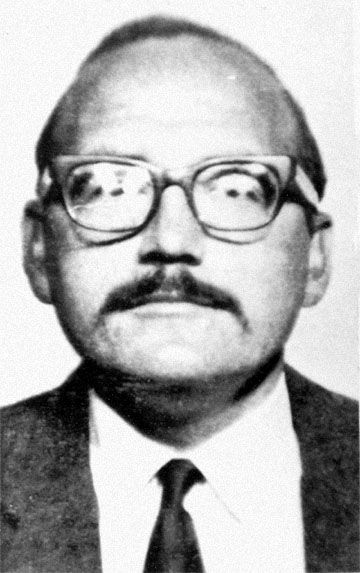
* A version of this entry was originally posted four years ago on the fortieth anniversary of the last known Zodiac crime, the murder of Paul Stine. When writing that blog entry, I hoped that I would have no need to write again about our failure to identify Stine’s killer. I hoped that future anniversaries would mark the end of this mystery and celebrate a final justice for Paul Stine. Sadly, yet another anniversary passes without answers. Time continues to deny Paul Stine the justice he deserves while we continue what sometimes feels like a futile search for answers. I will continue to hope that next year will be different, marking the end of this tragedy and justice for Paul Stine and all of the Zodiac victims.
——————————————————————-
In Memory Of Paul Stine: No Justice For The Dead
Forty-four years ago today, citizens of San Francisco found a brief article on the front page of The San Francisco Chronicle titled, “Cabbie Slain in Presidio Heights.”
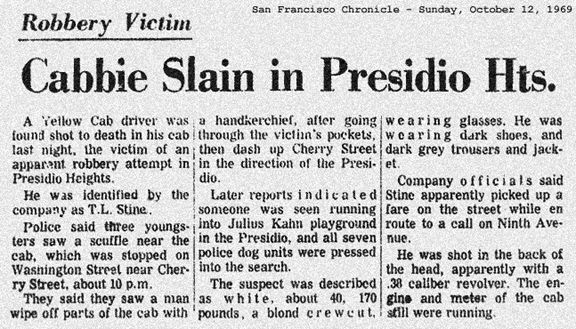
At the time, police believed that the victim, Paul Stine, had been killed during a routine robbery. No one knew that Stine’s murder would become one of the most infamous crimes in American history and that his killer would escape justice for decades.
On the night of October 11, 1969, Paul Stine climbed into his taxi cab to begin his night shift. He undoubtedly planned to finish his work and then return to his loving wife, his quiet home, and the rest of his life. Unfortunately, Paul Stine stopped on a San Francisco street to pick up a man in need of a ride. The man directed Stine to an upscale neighborhood known as Presidio Heights. Unbeknownst to Stine, his passenger was a murderer who called himself the Zodiac. While the man may have given Stine the impression that, once they reached the designated destination, he would simply pay the fare and go on his way, the man had other plans; he lied to Stine, knowing full well that he planned to execute the driver who was only doing his job.
Minutes later, Stine’s lifeless body lay in the front seat of the cab, his lifeblood escaping through the gunshot wound in his head. Perhaps Stine thought he was just going to be robbed and the gunman would then flee, or maybe Stine realized that he was about to die. No one knows his last thoughts as he may have seen his killer raising the gun to strike. Perhaps his entire life flashed before his eyes, as the movie-cliche goes. Perhaps he thought about his wife, or the children he would never raise. Maybe he thought about all he had hoped to accomplish. In that final moment, Stine may have wondered why the man wanted to kill him. When Stine pulled up to that curb and picked up his passenger, he planned to do his job and take the man where he wanted to go. In short, the passenger could trust Stine to do the right thing. Sadly, Stine had no such luxury, and his passenger was a murderer who lied in order to gain Stine’s trust just long enough to take his life.
For many, Paul Stine is just a body in the now-famous crime scene photograph, forever trapped in time, immortal yet devoid of life. Like all of us, Paul Stine was concerned about his future, even though he would never have one. In order to pay his way through college, Paul Stine worked a variety of jobs. Education meant a chance for a better life, a hope that he and his wife might live in some semblance of comfort and security. Decades after his senseless murder, the killer remains unidentified and his true motives remain unknown. The murderer enjoyed his freedom while his victim was frozen in that photograph, lost to history. Like all victims, Paul Stine deserves justice.
——————————————————————-
Those seeking information about this unsolved crime can view a collection of crime scene photographs, videos, newspaper articles, official documents, police reports, suspect sketches, and more at the ZodiacKillerFACTS Document Gallery.
Click on the links below to view the items on the list.
THE VICTIM
THE SCENE OF THE CRIME
* Washington and Cherry Streets – October, 1969
THE CRIME SCENE
THE EVIDENCE
THE INVESTIGATORS and OTHERS
* San Francisco Investigators and Others
THE SUSPECT SKETCHES
THE ZODIAC’S LETTER
* The Zodiac’s Envelope and Letter
THE ARTICLES
* Newspaper Stories and Other Material
THE JOE STINE FILES
THE DOCUMENTS
* Paul Stine: Certificate of Death
* Report by SFPD Officer Armand Pelissetti
* Excerpt from Dept. of Justice Report on Stine Case
* Memo on the Zodiac Sighting by SFPD Officer Don Fouke
THE VIDEOS
* The Crime Scene: Washington and Cherry Streets
* SFPD Officer Don Fouke on the Zodiac Sighting
* SFPD Captain Martin Lee on the Zodiac’s Threat to Attack a School Bus
* SFPD Captain Martin Lee on the Zodiac’s Crossed-Circle Symbol
* SFPD Captain Martin Lee on the Zodiac’s State of Mind
* MYSTERYQUEST: Paul Holes and the Murder of Paul Stine
Zodiackillerfacts.com also provides a collection of photographs, documents, videos and other reference material regarding the Zodiac’s other known crimes, including the shootings at Lake Herman Road and Blue Rock Springs Park as well as the attack at Lake Berryessa.
—————
Copyright 2013 ZodiacKillerFacts.com
MEDIA UPDATE
Former KGO-TV reporter Richard Carlson shares his memories of the Zodiac case in a new article posted at WeeklyStandard.com titled Signs of the Zodiac. Highlights include:
* Carlson recalls visiting the scene of the Stine murder in San Francisco on the night of the crime.
* A behind-the scenes account during the now-infamous televised exchange between attorney Melvin Belli and the Zodiac impostor known as “Sam” on The Jim Dunbar Show.
* A look at the events surrounding the proposed meeting between Belli and Sam after the television broadcast.
Find a link to the story and read more at the ZodiacKillerFacts Forum or go directly to the article Signs of the Zodiac.
THE RADIAN THEORY: Mistakes in the Myth-Making
— Zodiac theorists Gareth Penn, Steve Hodel and Raymond Grant promote the theory that the Zodiac crime scenes formed a geometric angle known as a “radian,” yet none of these men can accurately locate the crime scenes on a map. That fact is simply stunning.
THE BIRTH OF A THEORY
The Zodiac mailed one of his most controversial and mysterious pieces of mail in June 1970. The envelope contained a letter which was accompanied by a map of the San Francisco Bay Area. The writer also included a cipher comprised of 32 characters along with the explanation that the “map coupled with the code” would lead authorities to a buried bomb. On the edge of the enclosed map, the writer had added the notation, “is to be set to Mag. N.,” a reference to Magnetic North. In another letter, the Zodiac offered another hint and wrote, “PS. The Mt. Diablo code concerns Radians & # inches along the radians.”
A radian is an angle valued between 57 and 58 degrees, or, 57.296, defined as “an angle subtended by an arc of a circle equal in length to the radius of a circle.” The radian is the usual unit of measurement in higher mathematics, however, in applications of mathematics to surveying and navigation, the degree is more commonly used. The term “radian” is a contraction of the words “radius-angle.” [To learn more about radians, visit the ZodiacKillerFacts page Radians: By The Textbook.]
In his book Times 17, Zodiac theorist Gareth Penn claimed that he had discovered the true meaning behind the Zodiac’s cryptic radians clues. Penn wrote:
I was curious to discover what the Zodiac had meant by this rather bizarre suggestion. I bought a sheet of clear acetate and a marking pen. Using a protractor and a straightedge, I drew and angle of between 57 and 58 degrees on the acetate and then the acetate over a map of the Bay Area. I placed the apex of the angle on Mount Diablo, then rotated the angle until one leg passed through the scene of the murder at Blue Rock Springs. Then I felt as if a ton of bricks had fallen on me. The other leg of the angle went straight through Presidio Heights in San Francisco where the Zodiac had murdered the cabby. It was the most shocking experience of my entire life.
Penn had proposed a provocative solution to the Zodiac’s Mt. Diablo mystery by suggesting that the Zodiac had not only pre-selected the locations of the crime scenes based on some plan to construct a giant geometric angle but that the killer’s last known victim, cabdriver Paul Stine, was directed to an exact intersection where he was then murdered in order to complete the radian. The discovery of “the radian” generated attention for Penn and served as the foundation for his subsequent theories concerning the Zodiac’s methods, motives and identity. Penn’s radian theory was later adopted by other Zodiac theorists, including Steve Hodel and Raymond Grant. According to Grant, Gareth Penn and his suspect, Michael O’Hare, had conspired to commit the Zodiac crimes along with other co-conspirators. Like Penn, Grant cited the radian as evidence to support his claims, conclusions and theories. Other versions of radian theories were also promoted by Zodiac theorist Dennis Kaufman and others.
Penn’s radian theory became a prominent part of the Zodiac legend and was promoted by many believers, including Zodiac researcher Jake Wark and myself. During my 1999 appearance on the Learning Channel documentary Case Reopened, I explained the radian theory. My endorsement of Penn’s radian theory was later cited by Grant and others in support of that theory. However, my presentation of the radian theory was largely influenced by and based on Gareth Penn’s previous presentations. As a result, I had no idea that my presentation was actually severely flawed and inaccurate. In later years, my own desire to find the truth about the radian theory compelled me to re-examine the facts and to reassess my own beliefs. I had long-believed that the radian theory was valid, but my renewed research forced me to conclude that I had always been wrong.
A WILDERNESS OF ERROR
Penn claimed that the crimes scenes at Blue Rock Springs in Vallejo and Washington and Cherry Streets in San Francisco formed an angle measured at approximately 57.3 degrees, or one radian. In his book, Penn stated that the Vallejo crime occurred at the Blue Rock Springs golf course. However, the shooting actually occurred across the street and further East of the golf course in the parking lot of Blue Rock Springs Park.
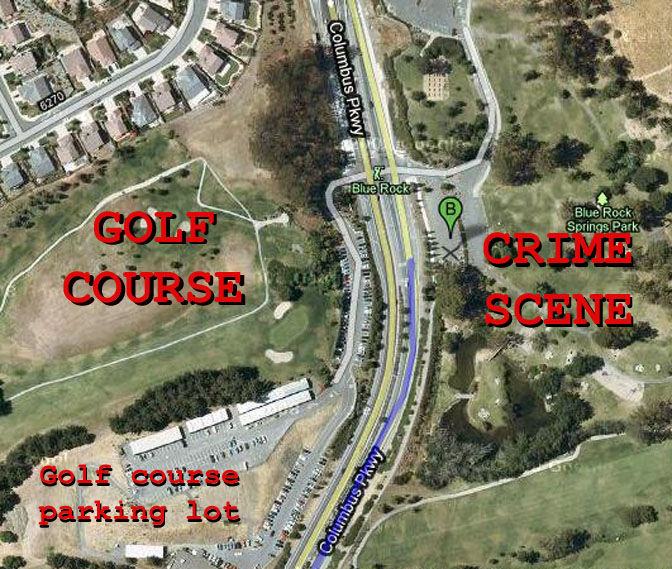
The golf course and the actual crime scene (marked “B”).
Penn was mistaken regarding the actual location of the Blue Rock Springs crime scene, an error which cast doubt on his radian theory and resulting conclusions. Some defenders of the radian theory suggested that the distance between the golf course and the park was insignificant when assessing the accuracy of the radian theory, but any Northeastern movement of the crime scene creates a geometric angle which is larger than previously measured from the golf course.
The problem was further compounded by the fact that Penn’s illustration of the Zodiac’s radian was incredibly inaccurate. For some reason, Penn placed the Blue Rock Springs crime scene more than four miles west of the correct location. This erroneous placement of the Vallejo crime scene did permit Penn to draw a radian angle from that scene, the San Francisco crime scene and the peak of Mt. Diablo. However, the inaccurate placement of the crime scene cast further doubt on Penn’s claims. An obvious irony was always evident in Penn’s illustration, an irony which I had previously failed to notice and still remains unnoticed by those who continue to promote Penn’s radian theory.
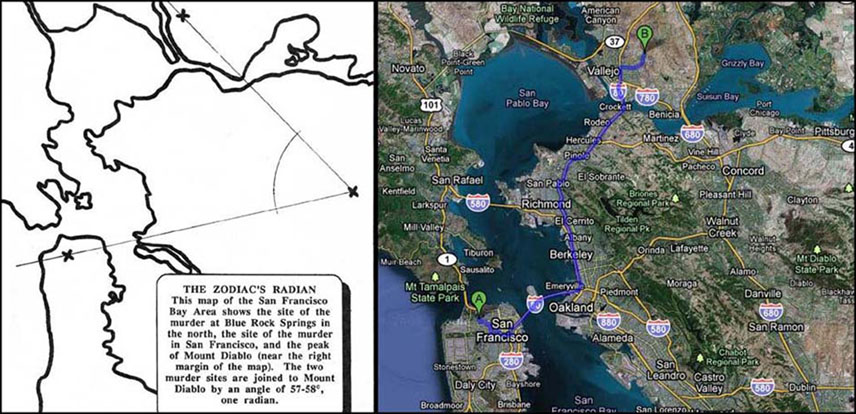
Penn’s incorrect placement of the Vallejo crime scene compared to the correct location.
Penn’s placement of the Vallejo crime scene was incorrect by several miles but his measurement from that incorrect location did form a radian angle. Yet, Penn’s illustration proves that a radian angle drawn from Mt. Diablo and the San Francisco crime scene does not pass through the Vallejo crime scene and completely misses the entirety of Blue Rock Springs Park as well as the adjoining golf course. Those who defended Penn’s theory often argued that the measurement of the radian was at least accurate regarding the entirety of Blue Rock Springs Park but the facts proved otherwise. Put simply, Penn’s own illustration proved that his theory was wrong.
Like many of those who promoted the radian theory, I was willing to accept a certain amount of inaccuracy regarding the measurement of the locations in question. I was wrong about the accurate location of the Vallejo crime scene and, therefore, the margin of error I had agreed to accept was greater than I realized. The angle created by the three locations was approximately 60 degrees or more, much larger than a radian of 57.3 degrees and that margin of error was too large to ignore or explain away as a simple mistake.
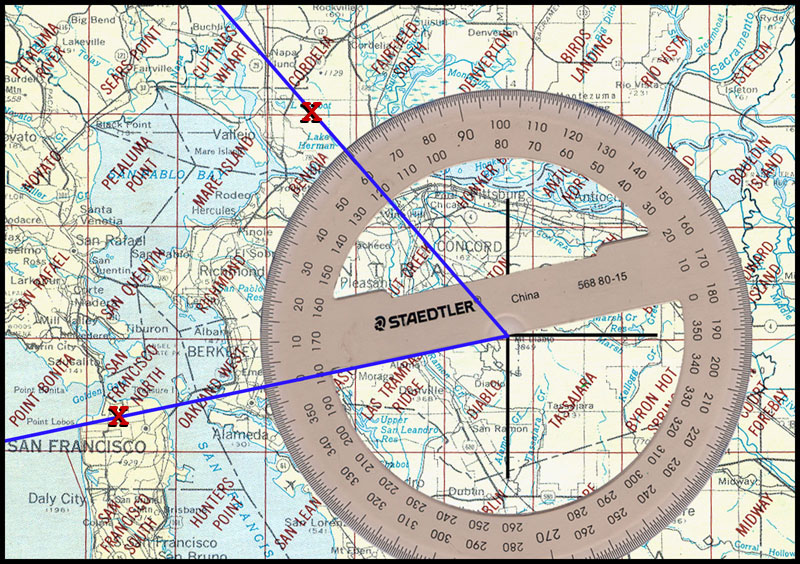
A U.S Geological Survey map with the correct locations marked at the peak of Mt. Diablo, the crime scene in San Francisco and the crime scene at Blue Rock Springs Park. The resulting angle measures approximately 60 degrees or more, larger than a radian of approximately 57.3 degrees.
Some defenders of the radian theory suggested that the radian was not meant to be accurate and only concerned the general locations of Blue Rock Springs Park and the Presidio Heights neighborhood in San Francisco where the Zodiac murdered cabdriver Paul Stine. However, the facts once again demonstrate that any angle based in the general area of Presidio Heights will not permit the other leg of the radian to pass through any portion of Blue Rock Springs Park, and vice versa. The facts proved that the radian theory was not valid. Gareth Penn was wrong, I was wrong, and so was anyone else who had ever promoted that theory as valid. Admitting errors is difficult for many people, but I conceded my mistakes and posted a public retraction of my endorsement of the radian theory at the ZodiacKillerFacts.com message board. That post also included an accurate presentation which proved that the radian theory was not valid.
A CONSTANT STATE OF DENIAL
After the facts proved that the radian theory was not valid, I retracted my endorsement of that theory and so did others. Jake Wark had since departed from the online community and did not comment on the issue, however, having studied this theory with him in the past, I believe that Jake would also concede that the radian theory is not valid. The Zodiac may have been attempting to create some sort of geometric construction by choosing specific locations for his crimes, but the evidence proved that the radian theory was wrong and that its promoters were wrong regarding the actual locations in question.
As I expected, many promoters of the radian theory were not willing to accept the facts which debunked that theory, especially when that theory played an important role in their own theories about the Zodiac’s methods, motives or identity. In another twist of irony, those who had previously claimed that the Zodiac had chosen the geographic locations of his crime scenes with cold-blooded calculation and accuracy then changed their approach and argued that the Zodiac was just referring to general areas and imprecise measurements. At the heart of this denial was the claim that most maps did not include enough detail to accurately locate and then measure the geometric relationships created by those locations. Penn wrote, “The accuracy of measurement depends in large measure on which map you use.” Zodiac theorist Raymond Grant promoted the radian theory as valid and wrote:
It’s true, of course, that you can find a map somewhere that does include all three points—a map of northern California, for example. The problem is, a map which covers an area large enough to include all three points will not allow for enough recognizable detail to pinpoint the murder sites in Presidio Heights and Blue Rock Springs with any degree of accuracy.
Grant also expanded Penn’s original theory and wrote:
The legs of the radian go through Presidio Heights (the neighborhood), Lake Herman Road (the rural road), and Blue Rock Springs (the park). Depending on how you situate the angle itself, there is a variance among the three murder sites of 1-2° on a map, which doesn’t seem like a lot considering that each leg of the angle is 35-40 miles long… As I said earlier, when one places a radian (57.29°) on a map of the Bay Area . . . with its apex on the above circled point of Mt. Diablo (VABM 3849) . . . so that the south leg of the angle goes through the intersection of Washington & Cherry Street (where Paul Stine was murdered) . . . the north leg goes through the murder scenes at Lake Herman Road and Blue Rock Springs.
Raymond Grant’s claim that the legs of the radian “go through Presidio Heights (the neighborhood), Lake Herman Road (the rural road), and Blue Rock Springs (the park)” is demonstrably false. The facts (and illustrations included here) demonstrate that Grant was wrong– a radian based in Presidio Heights will not pass through Blue Rock Springs Park at all. Grant’s stated certainty on this issue seemed odd given that he, himself, had also stated that maps which featured these three locations did not provide enough detail to “pinpoint” the locations in questions. If Grant could not obtain a map which featured the three locations and sufficient detail to identify those locations, how could Grant measure a radian based on these locations and conclude, with certainty, that the legs of that radian “go through” the three locations? According to Grant’s own claims, he could not conduct the necessary research and therefore had no factual basis for his conclusions.
Grant’s errors regarding the correct measurements of the locations in question are further compounded by his failure to accurately locate those scenes on a map. Like so many others, Grant apparently relied on Penn’s incorrect placement of the Vallejo crime scene as depicted in the illustration from the book Times 17. Like Penn, Grant’s illustration had incorrectly placed the Vallejo crime scene more than four miles West of the correct location. Grant also placed the Lake Herman Road crime scene approximately seven miles Northwest of the correct location.
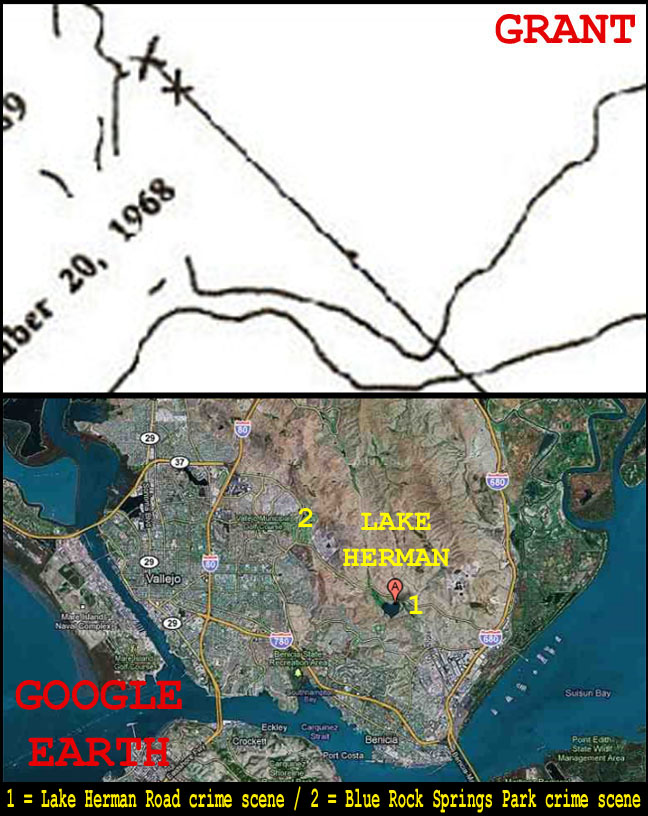
Grant’s placement of the crime scene locations compared to the accurate locations.
These incorrect placements permitted Grant to measure one radian angle from the San Francisco crime scene, and the general area of the Presidio Heights neighborhood, but Grant’s illustration was even more inaccurate than Penn’s. Grant’s placement of the Lake Herman Road crime scene was nowhere near the correct location and missed the entirety of Lake Herman Road itself. Grant had promoted the radian theory as valid when he could not even locate the crime scenes on a map. Grant’s own illustration proved that he was wrong.
The errors present in Penn’s work and my own previous attempts to assess the radian theory were undeniable, but the level of error in Grant’s presentations was simply stunning. Grant seemed to believe that a line drawn from Mt. Diablo would pass through both the Blue Rock Springs Park and Lake Herman Road crime scenes. Any line drawn from Mt. Diablo will not pass through both locations, as Grant would have realized if he had ever conducted the research necessary to support his own claims.
ANY ALTERNATIVE TO THE OBVIOUS
Raymond Grant’s continued promotion of the radian theory was puzzling and disturbing since the facts which debunked that theory were readily available to him for more than three years. Grant refused to accept the death of the radian theory because much of his own work was based on that theory. Grant wrote that the radian theory was “the starting point for the cryptographic speculation about the case,” and added, “Frankly, I don’t see any alternative to the obvious implication: The Zodiac committed those murders to create that angle on the map.” Grant refused to admit that the locations of those murders did not create that angle on a map.
A simple exercise will prove that Raymond Grant is not only wrong, but that the Zodiac could not have intended for anyone to believe what Grant claims. Using the map provided by the Zodiac, one can accurately locate the San Francisco crime scene at the intersection of Washington and Cherry Streets. Then, one can accurately locate what the Zodiac obvious intended others to interpret as the peak of Mt. Diablo.
Then, one can accurately locate the crime scene on Lake Herman Road, evident by its position just East of Lake Herman. Using a protractor to measure the angle created by the San Francisco scene, Mt. Diablo, and the crime scene on Lake Herman Road, one will immediately discover that the Lake Herman Road crime scene creates an angle of approximately 62 degrees or more, far from the 57.3 degrees necessary to create a radian.

The map used by the Zodiac with the peak of Mt. Diablo and the crime scenes on Lake Herman Road and in San Francisco.
The Lake Herman Road crime scene does not form a radian with the SF scene and Mt. Diablo, as the Zodiac’s own map clearly demonstrates. Therefore, the Zodiac must have known this fact if he was even moderately competent when locating the crime scenes and measuring the resulting angles. In order to believe that the Zodiac had access to accurate maps, selected the given locations, and intended a radian, one must believe that the Zodiac was as sloppy and inaccurate in his measurements as Gareth Penn, Raymond Grant and Steve Hodel. Grant’s Lake Herman Road radian theory was just as wrong as the original radian theory.
A HIGH DEGREE OF ERROR
At least three books promote the radian theory as fact while using that theory to “support” accusations of murder and claims to have solved the case. These three books were written by Gareth Penn, Raymond Grant and Steve Hodel. And yet, all three books are grossly inaccurate regarding the geographic locations in question– meaning, these three authors promoted the radian theory as valid and used that theory to accuse people of murder despite the fact that these three authors could not accurately locate the crime scenes on a map. That fact is simply stunning.
In his book Most Evil, Steve Hodel presented several illustrated maps designed to convince readers that his radian theories were valid. However, Hodel was wrong about the locations in question and the value of the angles shown in those illustrations. Hodel incorrectly stated that a radian is a valued between 58 and 59 degrees instead of 57.3 degrees. In one illustration, Hodel’s angle was actually between 53 and 55 degrees.
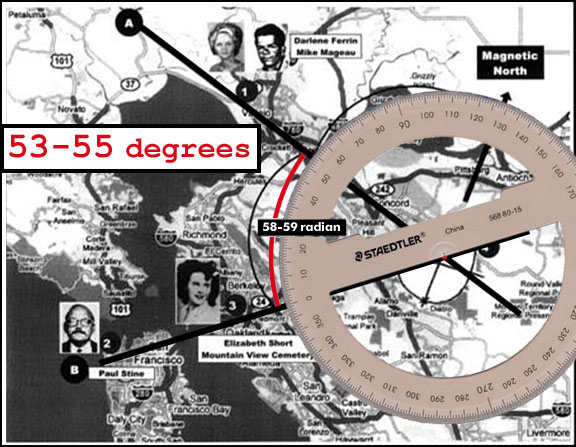
In his book MOST EVIL, Steve Hodel incorrectly stated that a radian was valued between “58-59 degrees,” yet the angle in the same illustration measures approximately 53-55 degrees. A radian measures approximately 57.3 degrees.
Hodel’s placement of the Blue Rock Springs Park crime scene was also incorrect. The author incorrectly placed the crime scene so far West that his radian leg almost missed the entire city of Vallejo.

Steve Hodel’s illustration placed the crime scene far West of the correct location.
Such errors would be inexcusable in a high school book report. Hodel’s illustrations also incorrectly placed the locations of other murder scenes and even the peak of Mt. Diablo. The angles featured in Hodel’s illustrations were so incorrect that one must conclude that Hodel never bothered to check the value of those angles or he deliberately misrepresented those values in order to falsely support his claims. Like Penn and Grant, Hodel continued to insist that his theories and presentations were accurate long after they had been debunked.
THE DEVIL IN THE DETAILS
Raymond Grant claimed that maps which featured the relevant locations do not provide enough detail to accurately identify those locations. One must question Grant’s assertion and wonder if he has ever tried to obtain such a map. Maps which feature all three locations and provide enough detail to accurately locate the crime scenes are readily available to anyone. In fact, the map used by the Zodiac provided adequate detail to identify the crime scenes. The USGS map used in the illustrations included with this article provide enough detail to identify the scenes, as do most maps. Gareth Penn reportedly used a map issued by the AAA (American Automobile Association) in his radian experiments. As seen in the image below, a map issued by the AAA features all three locations and provides adequate detail to accurately identify the locations in question.
Raymond Grant wrote: “And asking for 100% proof is what Mike Butterfield does when he DEBUNKS ideas. An idea is either 100% right, or it’s 100% wrong, and if he can find some microscopic nitpick in there, that proves his case.”
Grant’s placement of the Lake Herman Road crime scene was wrong by approximately seven miles and his placement of the Blue Rock Springs Park crime scene was wrong by approximately four miles. Grant claimed that these two crime scenes fall upon a straight line drawn from Mt. Diablo. Grant claimed that these two scenes formed a radian angle drawn from Mt. Diablo and the San Francisco crime scene. Grant claimed that most maps which show all three locations do not provide enough detail to accurately identify the correct locations. Grant claimed that his maps, illustrations, measurements and presentations were accurate and even more accurate than others. The facts demonstrate, beyond any and all doubt, that Raymond Grant’s claims are 100% wrong. That’s not my personal opinion– that’s an indisputable fact which can be easily verified in a matter of minutes using a map, a protractor and the facts. Therefore, Grant is 0.00% right. Again, that’s not my opinion but a proven fact. Given the absolutely stunning proportions of Grant’s colossal errors, no one can accurately refer to the debunking of his claims as “some microscopic nitpick.”
THE END OF A MYTH
The facts which debunk the radian theory are readily available to anyone who cares to look. Promoters of the radian theory use erroneous maps with the wrong locations and the wrong measurements, an irony which serves as the final proof that the radian theory is invalid– even its promoters failed to do their homework. Gareth Penn, Raymond Grant and Steve Hodel promote the radian theory, but, in order to do so, they must discard the facts in favor of falsehoods.
Gareth Penn’s radian theory may have been compelling and entertaining, and, many people– including myself– may have been fascinated by its simplicity and its possible implications. At its core, the radian theory is the kind of answer so many people seek from the Zodiac mystery, some sort of explanation which would help us understand why this tragedy occurred. Like most sensational “answers” in the Zodiac case, the radian theory seems initially impressive until one examines the facts.
—————————————————————————————–
RELATED LINKS:
The Radian Theory * The Mt. Diablo Map * The Mysteries of the Map
Radians & Inches * Radians: By The Textbook
The World According to Gareth Penn * Raymond Grant: The Zodiac Murders– Solved!
The World According to Steve Hodel * Most Evil and the Further Literary Crimes of Steve Hodel
________________________________________________________________________
Copyright ZodiacKillerFacts.com 2013 * All Rights Reserved
Forty-three years ago today…
Forty-three years ago today, the Zodiac mailed one of his most baffling clues and inspired one the most persistent myths in the history of the case. Read the ZodiacKillerFACTS article THE RADIAN THEORY: Mistakes in the Myth-Making and learn how to debunk this myth using a map, a protractor and the facts.
ZODIAC DNA: A Question of Answers
San Francisco’s Old Mint recently hosted a special screening of the 2007 film ZODIAC. Attending the event were San Francisco Chronicle writer Kevin Fagan, retired San Francisco Police Captain Al Casciato, and SFPD Inspector Pamela Hofsass.
Sandy Betts attended the screening and described the event in her message board posts. According to Betts, Hofsass told the audience that the San Francisco Police Department has obtained a partial profile of the Zodiac’s DNA. The same news was reported over a decade ago when the San Francisco Police Department announced that it had obtained a partial DNA profile from Zodiac communications. Then, investigators explained that the partial DNA profile would help to exclude suspects but could not be used to positively identify the Zodiac. The same would appear to be true today, as a partial profile can only eliminate an individual as the donor of the DNA. The partial profile cannot positively identify the Zodiac because the profile is incomplete. The DNA of a suspect may appear to match the partial profile but testing cannot accurately complete that match without a complete DNA profile from the Zodiac communications or other evidence. Until a complete profile is obtained, the new DNA profile may prove useful in reducing the ever-expanding list of suspects and clearing some of the confusion which continues to cloud this case.
Members of the Zodiackillersite message board wondered if Hofsass was referring to a “new” DNA profile or the same partial profile previously obtained from Zodiac envelopes in 2002. The questions prompted Sandy Betts to post a clarification which read: “I don’t want people to come to the the wrong conclusion as to what I said. (I need to make it more clear.) The DNA is a “partial” and with technology advancing as fast as it is, I was told that it can be used in the near future, not today or tomorrow but near future. Because it is only a “partial” it can not be entered into CODIS.”
In 2002, SFGate reported that the SFPD had obtained a partial DNA profile from suspected Zodiac communications. The article quoted SFPD Inspector Kelly Carroll: “We have something we haven’t had to this point, a partial DNA fingerprint.” Carroll conceded that profile was “not enough at this time to submit” to CODIS (Combined DNA Index System).
In a 2002 CNN interview, Carroll stated,”Well, in the instance of this case, as I said, Zodiac mailed letters to the local newspapers. Now, he claimed to have disguised his appearance and to have disguised his fingerprints so that police couldn’t find him. But one of the things that we did in examining the evidence is realize that in 1969 the idea of DNA was at best science fiction and so it was probable that Zodiac did not have any idea about disguising or hiding his DNA. And so we concluded that there was the possibility that we could recover biological material deposited by Zodiac when he licked the stamps and the envelopes that he used to send the letters.”
I spoke to Kelly Carroll in 2000, when he had been assigned to the Zodiac case along with his partner, the late Mike Maloney. Carroll was optimistic about the potential of modern forensic technology and said, “If this is case is solved, it will probably be solved by someone in a white lab coat.” Carroll and Maloney worked to process Zodiac evidence for possible DNA, and it’s encouraging to see that the San Francisco Police Department is still trying to solve the case after all these years.
DNA evidence proved invaluable in many cases, often serving as the last word which either identifies the guilty party or exonerates the wrongly accused. DNA evidence has exonerated at least 300 people including Damon Thibodeaux, who was recently released after serving more than fifteen years in prison for the rape and murder of his step-cousin.
DNA evidence has raised new and disturbing questions regarding the convictions of the so-called “West Memphis Three,” who had been imprisoned for the murders of three young boys but were recently released by a controversial Alford plea. Damien Echols, Jason Baldwin and Jessie Misskelley conceded that the prosecution possessed evidence to convict them in court, and, in exchange for their guilty pleas, the trio was released after serving eighteen years in prison. The case received renewed and increased scrutiny when newly-obtained DNA evidence appeared to implicate the step-father of one victim.
DNA evidence finally settled a decades-long debate regarding the guilt or innocence of accused “Boston Strangler” Albert DeSalvo. After a series of unsolved murders, DeSalvo claimed responsibility in confessions which were later challenged by those who doubted DeSalvo’s guilt and questioned the official conclusion that he alone was responsible for all of the murders attributed to the same strangler. Previous attempts to obtain DNA evidence from the body of an exhumed victim raised questions when the discovered evidence did not appear to match DeSalvo’s DNA. However, new testing has now proved that DeSalvo’s DNA was found on the body of the last strangler victim Mary Sullivan. The Sullivan family had questioned the DeSalvo solution for many years, and nephew Casey Sherman authored a book which suggested that other suspects may have been responsible for the Boston stranglings. Upon learning the news that new DNA evidence implicated DeSalvo in his aunt’s murder, Sherman conceded DeSalvo’s guilt and said, “I only go where the evidence leads.” He also he thanked investigators for their “incredible persistence.” History has apparently closed the book on the enduring mystery of the Boston Strangler, leaving other great mysteries awaiting their final answers.
Renewed efforts to obtain DNA evidence could provide surprising results which may implicate previously-dismissed suspects or exonerate others who many had claimed were undoubtedly guilty. When the San Francisco Police Department announced that suspected Zodiac DNA did not match the infamous suspect Arthur Leigh Allen, his accusers dismissed the evidence and continued to claim that he was somehow involved in the Zodiac crimes. The results of DNA evidence are usually ignored by those who accuse suspects excluded by that DNA evidence, so the new partial profile may do little to discourage amateur sleuths who are convinced that their suspect was the Zodiac killer.
News of possible DNA evidence raises hopes that we may someday have answers to some of the questions which persist in the ongoing debate about this case. Can DNA from the Zodiac communications be matched to the DNA from other writings and thereby prove that one individual was responsible for all of the suspected Zodiac letters? Will DNA taken from the Zodiac communications match DNA linked to other Zodiac crimes? Can the new DNA confirm or exclude a link between the Zodiac letters and writings related to the still-unsolved murder of victim Cheri Jo Bates?
I have followed and researched this case for a very long time, and I would be thrilled to see new evidence identify the Zodiac, but that may prove difficult if the Zodiac is not one of the known suspects and his DNA profile is not contained in the CODIS database. I hope that Inspector Kelly Carroll was right when he predicted that the case would be solved by forensic science. After more than four decades, this unsolved mystery needs to meets its end.
RELATED LINKS:
CHERI JO BATES and The ZODIAC: Unsolved Crimes and Unanswered Questions
Visit the ZodiacKillerFacts Forum to discuss this and other case-related issues.
Copyright 2013 ZodiacKillerFacts.com All Rights Reserved
San Francisco’s Old Mint…
San Francisco’s Old Mint recently hosted a special screening of the 2007 film ZODIAC. Inspector Pamela Hofsass attended the screening and reportedly told the audience that the SFPD has obtained a partial profile of Zodiac DNA. The SFPD had previously reported the same news more than a decade ago but the latest rumors indicate that investigators are still working to obtain new evidence which could finally solve the Zodiac mystery. Read the ZodiacKillerFacts blog entry ZODIAC DNA: A Question of Answers or visit the ZodiacKillerFacts Forum to discuss this and other case-related issues.


